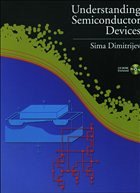Understanding semiconductor devices, as the building blocks of electronic circuits, is clearly of fundamental importance. In response to this challenge, this text, suitable for an advanced undergraduate or early graduate level course, is written to achieve the following goals: 1.)To meet the students' need to understand with: a)intuitive explanations of the underlying scientific concepts, b)explained fundamental equations, as opposed to using mathematics to explain physical phenomena, c)explained energy-band diagrams to provide rigorous and powerful presentations, which are easy to understand through an analogy with balls on a solid surface and bubbles in water, d)intriguing review questions, and a comprehensive set of worked out examples and problems. 2.)To provide a vertical (electronics-to-physics) hierarchy and a lateral (in terms of contents) flexibility. The electronics-to-physics approach motivates the students to learn the underlying scientific concepts and mathematical models by providing appropriate context and a continuous progression from the common-sense towards more abstract concepts. 3.)To provide CAD "nuts and bolts" with a small SPICE simulator widely used for computer-aided design of electronic circuits. The SPICE contents of this book provide a unique reference and pedagogical tools including: a)tabular presentations of the equations used as device models, b)hierarchically classified and explained SPICE parameters, c)case by case description of parameter measurement techniques, d)computer-based exercises that illustrate the effects of individual SPICE parameters on device and circuits characteristics. 4.)To provide links between the theoretical principles and real-life issues. The following points illustrate the level of integration achieved in this book: a)The device descriptions develop from application concepts (basic circuits). The underlying scientific concepts are "discovered" as needed. The introductions of particular device effects are explained by directly linked descriptions of what is happening on an atomic scale, b)Direct links are established between the fundamental equations and pragmatic SPICE models, c)Practically important issues such as reliability, device parameter measurements, etc., are presented such that they are directly related to the descriptions of fundamental device electronics and technology.
Understanding Semiconductor Devices is a main text for the advanced or graduate level course taught in virtually all departments of Electrical Engineering. The course commonly follows an overview of micrelectronics course such as that taught from our Sedra/Smith Microelectronic Circuits, Fourth edition The course is commonly called semiconductor devices, solid-state devices, or solid state physics. The strength of the Dimitrijev book is its integration of CAD tools which provide direct links to "real life" issues such as reliability. This more practical approach motivates the introduction to the electronics preceding the discussion of the device physics. Dimitrijev makes extensive use of diagrams and the text is complete with examples and effective exercises.
Understanding Semiconductor Devices is a main text for the advanced or graduate level course taught in virtually all departments of Electrical Engineering. The course commonly follows an overview of micrelectronics course such as that taught from our Sedra/Smith Microelectronic Circuits, Fourth edition The course is commonly called semiconductor devices, solid-state devices, or solid state physics. The strength of the Dimitrijev book is its integration of CAD tools which provide direct links to "real life" issues such as reliability. This more practical approach motivates the introduction to the electronics preceding the discussion of the device physics. Dimitrijev makes extensive use of diagrams and the text is complete with examples and effective exercises.

